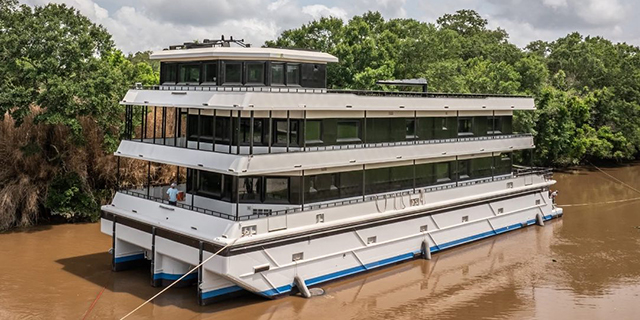Landry’s influence still growing
Published 6:00 am Sunday, September 19, 2021

- After his career in architecture that started in New Orleans and continued in New Iberia, Al Landry went into the restaurant business when his wife encouraged him to purchase a small café, ‘Lagniappe,’ in Franklin.
It’s undeniable that Al Landry has helped shape New Iberia. The 91-year-old architect, artist, restaurateur and cultural icon reflected recently on his contributions to the Queen City of the Teche even as some of his influences continue to grow in the city.
Landry, who has family roots here, was a practicing architect in New Orleans — “very happily situated,” he recalled — when an opportunity arose. He was asked to join a New Iberia firm.
“So, I left New Orleans and came here. I was related to half of the town — more than half — related to everybody. And they thought that would contribute a lot.”
But those ties were never fully tested. About two months later, the firm was unexpectedly dissolved. Nonetheless, Landry ended up on his feet and continued his career. Clients included city government and the parish school board.
More than 20 years later — in 1986 — Landry turned over a new leaf. Or, you might say, a napkin.
By then, Landry was making frequent business trips to the nearby town of Franklin. On the way out of town, he’d stop at the corner of Main and Julia Streets for breakfast and coffee at a small café, “Lagniappe,” which was owned and operated by a California couple.
When the bottom fell out of the oil industry, the Californians prepared to move to New Orleans. Encouraged by his wife Elaine, Landry decided to become a restaurant owner, rather than merely a former customer.
“We decided to open a little snack shop, serving gumbo and chicken salad sandwiches — and coffee, of course,” Landry recalled. “It just kind of took off from there. It kept growing and getting more popular, but we had no room — we only had about four or five tables.”
Providence intervened: the space right next door became available to rent. The only thing that stood in the way was the brick wall between the two spaces, so Landry simply carved out a few openings and expanded the restaurant’s footprint.
The Landrys served lunch on weekdays and initially, also opened on Friday and Saturday nights. All was well until football season started. Once that happened, the place was empty on Saturday nights.
“So, we decided to just keep it open on Friday evenings, and we lasted for 25 years,” said Landry.
In that time, the couple created a mainstay of New Iberia’s food and music scene. The restaurant was closed in 2011, when the couple retired. Elaine, a native of Chicago whose mastery of Cajun cooking poured out of the restaurant kitchen — and who also entertained guests with her skill at the piano — passed away in 2017.
“That was pretty remarkable for people that didn’t know a thing about the restaurant business,” Landry observed.
Landry has made other cultural contributions — in theatre and visual art.
As a college student, Landry took part in stage performances at the University of Colorado in Colorado Springs. So, when he took that short-lived job as an architect in New Iberia, he paid special attention to what was happening in the local theatre scene.
“When I first arrived, the New Iberia Little Theatre was doing very well, putting on wonderful shows.”
Landry joined the troupe, using his skill as an artist to paint background scenery. He also became known as an excellent portrait painter. His series, “Ladies in Hats,” comprised portraits of New Iberia women.
Today, Landry’s work with New Iberia’s Trilingual Marker Trail, a project that pays homage to the city’s original identity, is continuing. Iberia Cultural Resources Association Executive Director Cathy Indest said donations are being sought to place another series of the permanent historical markers around the city.
Landry said he’d like to make Spanish history more accessible to residents and visitors, which is why he suggested the inclusion of Spanish as the third language on the Trilingual markers.
From 1763 to 1802, Louisiana was a Spanish colony. Now, New Iberia is the only remaining city in the state founded by the Spanish. Few remnants of that Spanish influence remain — a few downtown balconies featuring scrolled ironwork, the moniker “Spanish” Lake, and architecture around Bouligny Plaza. Landry said it was only right that the plaques marking the city’s history carry the native tongue of its founders.
Landry’s 92nd birthday will roll around in November. Sometimes, his hearing isn’t quite up to par — and he’s stopped painting because of his declining eyesight. But his enthusiasm for New Iberia is indefatigable.
“You never feel exactly what your age is,” Landry said.
Author Sarah Spell contributed to this report.





